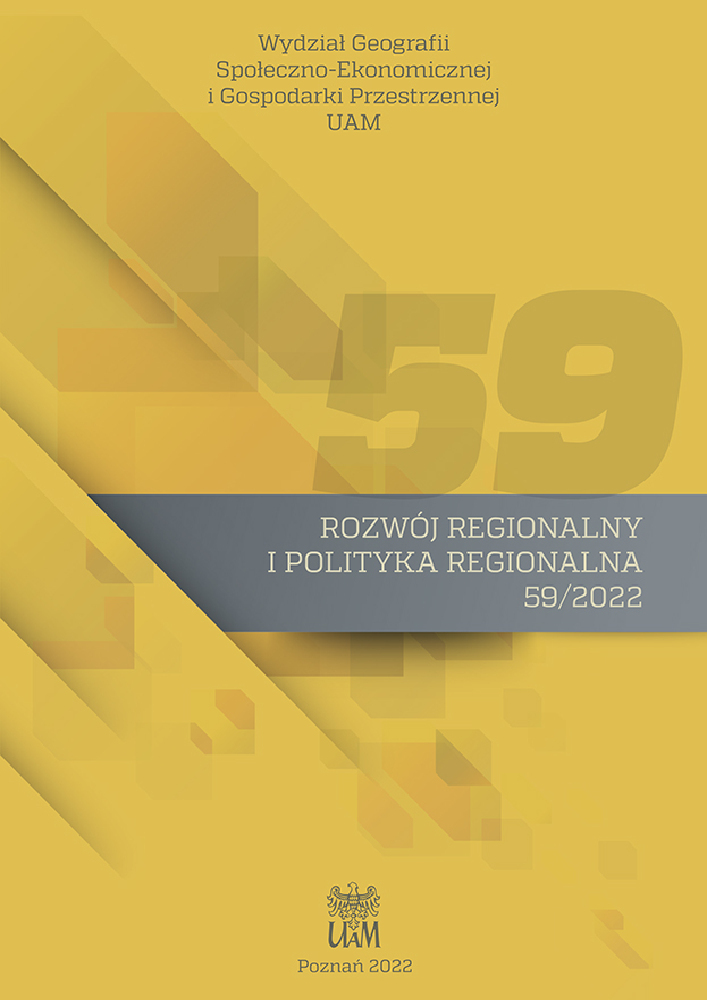Abstract
Spatial planning, in addition to individual needs and habits, is a key aspect of shaping travel patterns. Especially in cities, features of the built environment and functions of places, as well as their mutual location, decide about the popularity of particular ways of traveling. Public transport, private cars, or non-motorized modes have their advantages over the specific conditions, in which the optimal means of transport may vary. The (re)gaining worldwide popularity of bicycles, arousing the interest of both transport geography researchers and local authorities, can play the role of an effective and easily accessible remedy for many problems related to the functioning of cities and life in them. Representing the economy of sharing, public bike systems meet the needs of residents who, due to the undoubted convenience of this solution, may decide to use them during their daily journeys. Poznań City Bike, operating since 2012, allows you to move between rental stations, located in the most important parts of the city, without the need to have your own vehicle. In this study, a travel analysis made as part of the said system in the season 2021 in selected districts in the north of the city was carried out, using GIS tools and statistical methods. The results indicate a significant relationship between the popularity of bike sharing and specific features of the built environment. The work allowed for the creation of the development conception of bicycle infrastructure in the area of the study.
References
Bhat C.R., Sen S., Eluru N. 2009. The impact of demographics, built environment attributes, vehicle characteristics, and gasoline prices on household vehicle holdings and use. Transportation Research, Pt B, Methodological, 43(1): 1-18. https://doi.org/10.1016/j.trb.2008.06.009 DOI: https://doi.org/10.1016/j.trb.2008.06.009
Bieliński T., Kwapisz A., Ważna A. 2019. Bike-Sharing Systems in Poland Sustainability, 11: 2458. https://doi.org/10.3390/su11092458 DOI: https://doi.org/10.3390/su11092458
Cervero R., Sarmiento O.L., Jacoby E., Gomez L.F., Neiman A. 2009. Influences of built environments on walking and cycling: lessons from Bogotá. Int. J. Sustain. Transport., 3(4): 203-226. https://doi.org/10.1080/15568310802178314 DOI: https://doi.org/10.1080/15568310802178314
Chojnacka K. 2017. Program rowerowy miasta Poznania 2017-2022 z perspektywą do roku 2025. Załącznik do uchwały Rady Miasta Poznania nr XLVIII/843/VII/2017 z dnia 16 maja 2017 r.
Chojnicki Z. 1966. Zastosowanie modeli grawitacji i potencjału w badaniach przestrzenno-ekonomicznych. Państwowe Wydawnictwo Naukowe.
DeMaio P. 2009. Bike-sharing: History, Impacts, Models of Provision, and Future. Journal of Public Transportation, 12(4): 41-56. https://doi.org/10.5038/2375-0901.12.4.3 DOI: https://doi.org/10.5038/2375-0901.12.4.3
Faghih-Imani A., Eluru N., El-Geneidy A., Rabbat M., Haq U. 2014. How land-use and urban form impact bicycle flows: evidence from the bicycle-sharing system (BIXI) in Montreal. J. Transp. Geogr., 41: 306-314. https://doi.org/10.1016/j.jtrangeo.2014.01.013 DOI: https://doi.org/10.1016/j.jtrangeo.2014.01.013
Fishman E., Washington S., Haworth N. 2013. Bike Share: A Synthesis of the Literature. Transport Review, 33: 148-165. https://doi.org/10.1080/01441647.2013.775612 DOI: https://doi.org/10.1080/01441647.2013.775612
Frey H., Mayerthaler A., Leth U. 2017. New indicators for new infrastructure. Road and Rail Infrastructure, IV.
Gadziński J. 2012. Ocena negatywnych oddziaływań transportu drogowego na środowisko przyrodnicze. Przegląd Komunikacyjny, 1: 14-19.
Hyła M. 2017. Standardy techniczne i wykonawcze dla infrastruktury rowerowej miasta Poznania. Urząd Miasta Poznania, Biuro Koordynacji Projektów i Rewitalizacji Miasta.
Kisiała R., Rudkiewicz M. 2017. Zastosowanie diagramu Woronoja w badaniu przestrzennych wzorców rozmieszczenia i dostępności sklepów dyskontowych. Przegląd Geograficzny, 89: 187-212. https://doi.org/10.7163/PrzG.2017.2.1 DOI: https://doi.org/10.7163/PrzG.2017.2.1
Médard de Chardon C., Caruso G., Thomas I. 2017. Bicycle sharing system 'success' determinants. Transportation Research, Pt A, Policy and Practice, 100: 202-214. https://doi.org/10.1016/j.tra.2017.04.020 DOI: https://doi.org/10.1016/j.tra.2017.04.020
Montgomery C. 2015. Miasto szczęśliwe. Jak zmienić nasze życie, zmieniając nasze miasta. Wydawnictwo Wysoki Zamek, Kraków.
O'Brien O., Cheshire J., Batty M. 2014. Mining bicycle sharing data for generating insights into sustainable transport systems. Journal of Transport Geography, 34: 262-273. https://doi.org/10.1016/j.jtrangeo.2013.06.007 DOI: https://doi.org/10.1016/j.jtrangeo.2013.06.007
Parysek J. 2006. Wprowadzenie do gospodarki przestrzennej Wyd. Uniwersytetu im. A. Mickiewicza, Poznań.
Radzimski A., Dzięcielski M. 2021. Exploring the relationship between bike-sharing and public transport in Poznań, Poland. Transportation Research, Pt A, Policy and Practice, 145: 189-202. https://doi.org/10.1016/j.tra.2021.01.003 DOI: https://doi.org/10.1016/j.tra.2021.01.003
Shaheen S.A., Guzman S., Zhang H. 2010. Bikesharing in Europe, the Americas, and Asia. Past, Present, and Future Transportation Research Record, 2143: 159-167. https://doi.org/10.3141/2143-20 DOI: https://doi.org/10.3141/2143-20
Steg L. 2005. Car use: lust and must. Instrumental, symbolic and affective motives for car use. Transportation Research, Pt A, Policy and Practice, 39(2-3): 147-162. https://doi.org/10.1016/j.tra.2004.07.001 DOI: https://doi.org/10.1016/j.tra.2004.07.001
Stryjakiewicz T., Kołsut B., Doszczeczko B., Dyba W., Kisiała W., Kudłak R., Wojtyra B. 2021. Przegląd ekonomiczno-przestrzennych badań rynku samochodów osobowych. Przegląd Geograficzny, 93: 249-268. https://doi.org/10.7163/PrzG.2021.2.6 DOI: https://doi.org/10.7163/PrzG.2021.2.6
Walker P. 2018. Jak rowery mogą uratować świat. Wydawnictwo Wysoki Zamek, Kraków.
Wang K., Akar G., Chen Y.J. 2018. Bike sharing differences among Millennials, Gen Xers, and Baby Boomers: Lessons learnt from New York City's bike share. Transportation Research, Pt A, Policy and Practice, 116: 1-14. https://doi.org/10.1016/j.tra.2018.06.001 DOI: https://doi.org/10.1016/j.tra.2018.06.001
Wolny A. 2018. Introducing smart mobility in polish functional urban areas with a use of innovative individual transport systems - supply and demand, diversity, spatial distribution. 18th International Multidisciplinary Scientific GeoConference SGEM 2018, s. 757-764. https://doi.org/10.5593/sgem2018V/6.4/S10.094 DOI: https://doi.org/10.5593/sgem2018V/6.4/S10.094
License
Copyright (c) 2022 Bartosz Doszczeczko

This work is licensed under a Creative Commons Attribution 4.0 International License.

